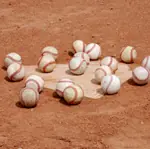
It's amazing how youth baseball teams and beyond do not practice some fundamental aspects of the game.
From my standpoint, the reason I practice certain things other coaches may not is because I've been burned by other teams and have lost games and championships because of it. In my 21 years coaching youth baseball, the list of things that should be practiced is long but some situations come up over and over again. Here are four of the biggest practice mistakes you should avoid with your squad:
More: 5 Ways to Get Noticed at a Sports Camp
Mistake No.1: Pitchers Not Practicing Fielding
This issue is incredible to me, though it took a few years before I began having my pitchers practice fielding. When youth baseball teams practice fielding, usually it will include every position but the pitcher.
Youth baseball coaches need to put pitchers on the mound in practice and include them in fielding drills. Coaches also need to rotate the pitchers. Have the pitcher go through his pitching motion without the ball. The coach then throws or hits a baseball to him. And not just right at him. Hit the balls to the left, center and right of him. Then put one or more runners on base and declare how many outs there are and continue hitting to him and let him decide which base to throw to.
Try also having the coach hit ground balls to the pitcher on the mound and instead of trying to catch it clean, he has to knock it down, establish himself and then field the ball. The drills work and also get pitchers familiar with game situations.
More: Drill of the Weelk: Baseball Fielding Drill for Kids
Mistake No.2: Catching a Foul Ball Near a Fence
I swear I'm the only one in my league who takes this serious. Probably because I've seen more catchable foul balls hit the ground than any team in my league.
The scenario usually starts with a pop fly just foul of first base. The ball moves deeper into foul territory. The first baseman looks like he has a beat on the ball as he gets closer to the fence or dugout. He then looks like he is hesitating the further he moves into foul territory. Then "plop"! The ball falls right near his feet about 12-24 inches from the fence.
Of course we all know the consequences of giving away outs in youth baseball. This stuff kills me. So how can we coaches rectify this?
At least once a year, usually before the season, I do the "Fence Drill" with my team. I first start on the first-base side, having the players line up behind each other about six feet from the fence in foul territory parallel to first base. (I'm located around home plate.)
I throw pop ups as close to the fence as I can and instruct my players to track the ball. As they do this they should come right near the fence and, either with their glove hand if they are a righty or free hand for lefties, put their arm out feeling for the fence then proceed to track and catch the ball from there.
This is getting them used to feeling for structures while keeping their eye on the ball. It makes them more comfortable and helps limit the fear of getting hurt. I then move the line closer to fair territory eventually moving the line where every player is a first baseman and has to hustle to feel for the fence first then catch the ball. I then move the line to the third base side of the infield.
Is this drill foolproof? Absolutely not! But I did notice a few more catches over the course of a season if we practiced this drill.
- 1
- of
- 2









Discuss This Article